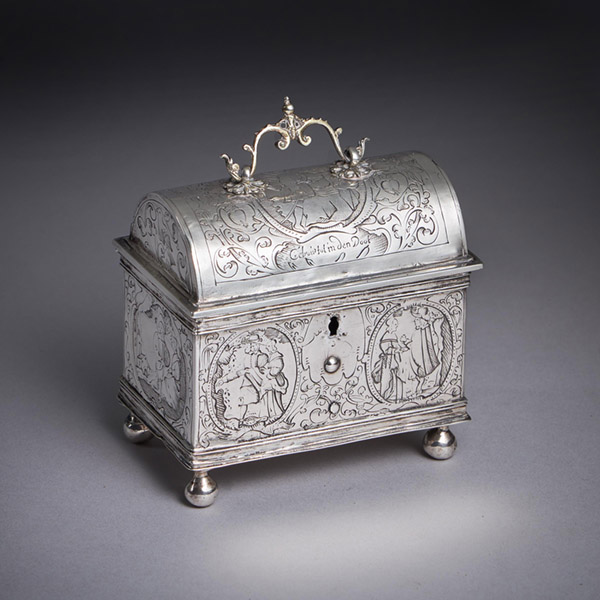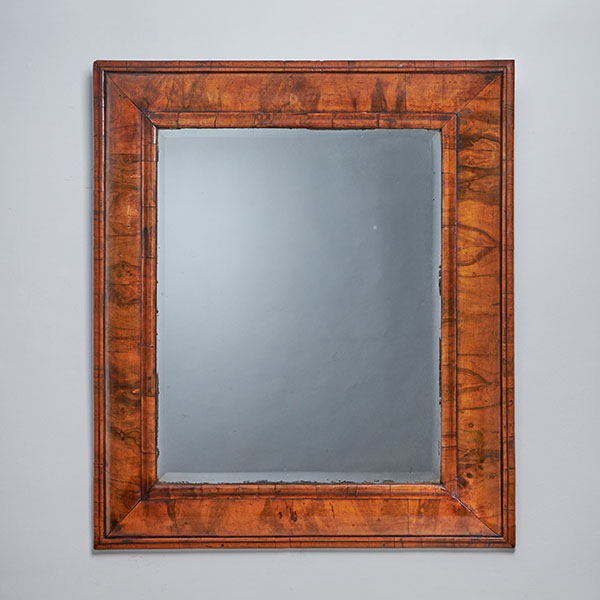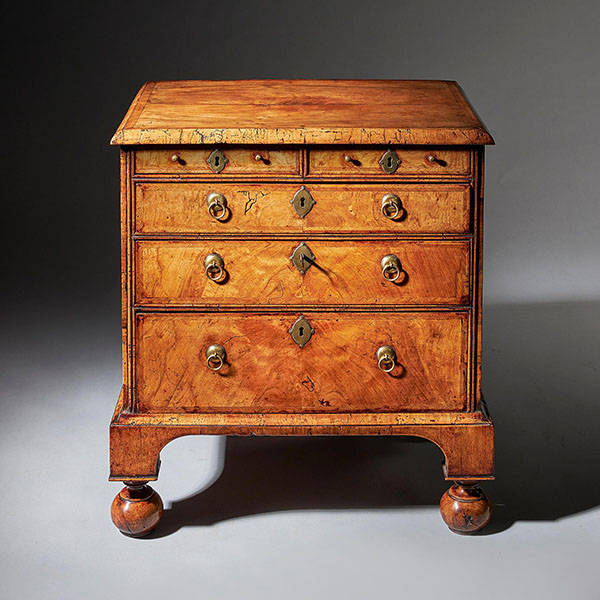17th Century William and Mary Eight-Day Spring-Driven Table Clock, Circa 1695
Sold
Request Information
Follow Us
17th Century William and Mary Eight-Day Spring-Driven Table Clock, Circa 1695
An early English eight-day spring-driven table clock signed Henry Massy London, dating to the period c.1695-1700.
The elegantly proportioned ebony-veneered early inverted bell top case has windows on all sides so that the movement and the engraved backplate can be admired. The front and the sides have pierced wooden silk-backed sound frets above the glazed panels. It has cast brass pineapple finials to the corners, is surmounted by a shaped hinged carrying handle and rests on wooden bracket feet.
The fine square brass dial with matted centre has a narrow applied silvered chapter-ring, date aperture, false pendulum aperture, and gilded winged cherub-head spandrels. The chapter-ring is engraved with a narrow outer minute ring within which are Arabic five-minute numerals, a central ring of Roman hours I-XII and red half-hour markers and an inner ring divided into quarter-hours. The elegant original blued steel hands are finely pierced. The dial is signed on a plaque behind the false pendulum Massy London
The eight-day single train fusee brass movement has verge escapement with a short knife-suspended pendulum. The backplate is profusely engraved in period style around a typical signature cartouche with the maker’s name: Henry Massy London. The movement has pull-quarter repeat on two bells differing in pitch, and a larger hour bell.
The maker
Henry Massy, also Massey (c.1664-1720) was the son of Nicholas Massey, a Huguenot immigrant and well-known clockmaker. Henry was made a Free Brother in the Clockmakers’ Company in 1692. He was married to Anne Brissett in 1691. He was established in St James Westminster. Several longcase, as well as numerous watches and bracket clocks are known.
Condition
Good. Wear consistent with age and use.
Dimensions
Height: 15.36 in. (39 cm)
Width: 9.26 in. (23.5 cm)
Depth: 6.7 in. (17 cm)
Literature
B. Loomes, The Clockmakers of Great Britain 1286-1700, Ashbourne, 2014, pp.338-339.
PREVIOUSLY SOLD
No Results Found
The page you requested could not be found. Try refining your search, or use the navigation above to locate the post.
No Results Found
The page you requested could not be found. Try refining your search, or use the navigation above to locate the post.
YOU MAY ALSO LIKE

A Fine William and Mary 17th Century Figured Walnut Cushion Mirror C, 1690
A Fine William and Mary 17th Century Figured Walnut Cushion Mirror C, 1690 £6,500Follow UsA Fine William and Mary 17th Century Figured Walnut Cushion Mirror C, 1690 A large William and Mary 17th century figured walnut cushion mirror, circa...

A museum-grade mid-17th century Dutch silver marriage casket or knottekistje, circa 1660
A museum-grade mid-17th century Dutch silver marriage casket or knottekistje, circa 1660 £9,500 [wpforms_selector form_id="11387" show_title="on" _builder_version="4.22.1" _module_preset="default" custom_margin="-30px||||false|false"...

Large William and Mary 17th Century Figured Walnut Cushion Mirror c, 1690
Large William and Mary 17th Century Figured Walnut Cushion Mirror c, 1690 £7,495[wpforms_selector form_id="11387" show_title="on" _builder_version="4.22.1" _module_preset="default" custom_margin="-30px||||false|false" global_colors_info="{}"...

An extremely rare George I walnut chest of small proportions on ball and bracket
An extremely rare George I walnut chest of small proportions on ball and bracket £18,800[wpforms_selector form_id="11387" show_title="on" _builder_version="4.22.1" _module_preset="default" custom_margin="-30px||||false|false"...

A Rare 18th Century George II Musical Table Clock by Matthew King, c. 1735.
A Rare 18th Century George II Musical Table Clock by Matthew King, c. 1735. £24,500[wpforms_selector form_id="11387" show_title="on" _builder_version="4.22.1" _module_preset="default" custom_margin="-30px||||false|false"...

Signed Mid 19th C. Edo/Meiji Period Diminutive Lacquer Stacking Cabinet, Japan
Signed Mid 19th C. Edo/Meiji Period Diminutive Lacquer Stacking Cabinet, Japan £5,800[wpforms_selector form_id="11387" show_title="on" _builder_version="4.22.1" _module_preset="default" custom_margin="-30px||||false|false"...

A Fine William and Mary 17th Century Figured Walnut Cushion Mirror C, 1690
A Fine William and Mary 17th Century Figured Walnut Cushion Mirror C, 1690 £6,500Follow UsA Fine William and Mary 17th Century Figured Walnut Cushion Mirror C, 1690 A large William and Mary 17th century figured walnut cushion mirror, circa...

A museum-grade mid-17th century Dutch silver marriage casket or knottekistje, circa 1660
A museum-grade mid-17th century Dutch silver marriage casket or knottekistje, circa 1660 £9,500 [wpforms_selector form_id="11387" show_title="on" _builder_version="4.22.1" _module_preset="default" custom_margin="-30px||||false|false"...

Large William and Mary 17th Century Figured Walnut Cushion Mirror c, 1690
Large William and Mary 17th Century Figured Walnut Cushion Mirror c, 1690 £7,495[wpforms_selector form_id="11387" show_title="on" _builder_version="4.22.1" _module_preset="default" custom_margin="-30px||||false|false" global_colors_info="{}"...

An extremely rare George I walnut chest of small proportions on ball and bracket
An extremely rare George I walnut chest of small proportions on ball and bracket £18,800[wpforms_selector form_id="11387" show_title="on" _builder_version="4.22.1" _module_preset="default" custom_margin="-30px||||false|false"...

A Rare 18th Century George II Musical Table Clock by Matthew King, c. 1735.
A Rare 18th Century George II Musical Table Clock by Matthew King, c. 1735. £24,500[wpforms_selector form_id="11387" show_title="on" _builder_version="4.22.1" _module_preset="default" custom_margin="-30px||||false|false"...

Signed Mid 19th C. Edo/Meiji Period Diminutive Lacquer Stacking Cabinet, Japan
Signed Mid 19th C. Edo/Meiji Period Diminutive Lacquer Stacking Cabinet, Japan £5,800[wpforms_selector form_id="11387" show_title="on" _builder_version="4.22.1" _module_preset="default" custom_margin="-30px||||false|false"...










